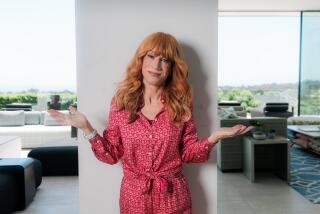First Lady’s Breakfast: She’s Not Ready for Retiring Role
- Share via
Nancy Reagan is coming back to town. And she’s not coming back to pour tea.
The First Lady showed Monday morning just what a powerful presence she’s going to be when her buddy Merv Griffin hosted a breakfast and what he called “a little rehearsal for eight months from now when we will have Nancy and the President back with us.”
After Mrs. Reagan left the breakfast, Griffin underscored her planned activist role, saying the First Lady had told him, “I cannot come back to the community and pour tea every day. I would go out of my mind.”
Earlier, Griffin had introduced the First Lady, saying she and her husband would be a “major force in Southern California. That’s why all of you major forces are invited here today.” Indeed, the group gathered in the tennis pavilion on Griffin’s manicured Beverly Hills estate was as influential a crowd as could be assembled on either coast.
Griffin had put together the breakfast meeting to raise $5 million of the $10 million needed for the proposed Nancy Reagan Center for young drug abusers here--and the consensus from Griffin and some of his well-known guests was that even though no pledges were taken at the meeting, the goal would be reached without a major problem.
That goal could be reached “from your table alone,” Michael King, president of King World, kidded the genial Griffin, whose table included the First Lady, developer David Murdock (seated at her right), financier Marvin Davis, Hollywood Park’s Marje Everett, hotel king Barron Hilton and Giorgio’s Fred Hayman.
At the three other tables were more brand-names than are known to crowd anything accept the Forbes Four Hundred, with corporate heads like Unocal chair Fred Hartley, Thrifty Drug chair Leonard Straus and TransAmerica’s David Carpenter, entertainment moguls like Jerry Weintraub and Grant Tinker, attorney Harvey Silbert, architect Charles Luckman, Arthur Anderson western vice president Sheldon Ausman, Korn/Ferry International president Richard Ferry and Abigail Van Buren Phillips.
Waiting for them on the bamboo chairs were white folders with the First Lady’s signature printed in red. In the folders: a description of the proposed Nancy Reagan Center at Phoenix House; an annual report of Phoenix House, the 21-year-old private nonprofit drug abuse services agency; and a discreet brochure explaining the levels of possible contributions--$1 million or more to qualify for distinguished benefactor status, $250,000 to $1 million for benefactors, and sponsors at the $25,000 level.
Many at the breakfast were old friends of the Reagans, and the First Lady was as cheery as the sunny morning, despite the fact that, as Griffin explained to former NBC head Tinker, “she worked all night in Burbank and her cue cards were all mixed up.” (Mrs. Reagan had tacked on an appearance on a Bob Hope NBC special after first planning the West Coast trip to appear at the breakfast.)
Despite her TV stint, she was bouncy in a black, white and red Adolfo dress and matching sweater, greeting each of the breakfast’s two dozen attendees and chatting for a minute while the White House photographer snapped pictures. The private Nancy Reagan--warm, hugging, patting friends on the back--was in full force and showing just where the extraordinary loyalty she has always engendered has its roots.
The crowd settled down for a breakfast cooked in-house that would destroy any fashionable figure. As the menu described it, there was “smoked Washington State salmon and sturgeon, New York bagels . . . baked Sonoma County ham, fried apples, scrambled eggs, buttermilk biscuits, fresh fruits. . . .”
And then, the real meat of the meeting, the talk from Mrs. Reagan (who, by federal law, had to leave before any actual fund-raising mention was made).
She first kidded Griffin, thanking him for taking the time, saying, “You could have been out taking over something, Merv.” But then, it was all business, as she first “put to rest the whole idea” that her anti-drug campaign was “a P.R. thing created for me,” citing a Sacramento interview about the need to combat drug abuse during the time her husband was governor of California.
Even her anti-drug slogan, “Just Say No,” Mrs. Reagan stressed, came spontaneously when she was asked by a girl in Oakland what someone should say when offered drugs.
Moving the national consciousness to an anti-drug position was not easy, the First Lady said, pointing out that, it took five years before there was a slackening of positive pictures of drug use painted by the entertainment industry. Some progress has been made, but there is still a tremendous need for education and for facilities to help youthful drug abusers, she said.
“The final answer lies in taking the customers away from the product. . . . We’ve got to do it, and I need your help,” she told the group, saying that there was “a chance to get this property.”
$10 Million Needed
The site picked out for the Nancy Reagan Center in the Los Angeles area is a bankrupt three-building hospital in Lake View Terrace, for which about $10 million is needed, covering the acquisition of the property and its conversion. That part of the story was explained by Mitch Rosenthal, the president of Phoenix House. (Some of those in the breakfast group are long-time Phoenix House board members, including Tinker, Mickey Ziffren and Suzanne Marx, who is the campaign director for the Nancy Reagan Center fund-raising drive.)
Rosenthal told the group his New York Phoenix House facility was Mrs. Reagan’s “first stop years ago when she began her crusade to make drugs no longer glamorous.” The First Lady, he said, has “personally seen hundreds of kids who have been able to regain control of their lives” through the Phoenix House approach.
Neighborhoods were not always enthused at the locations of the Phoenix House facilities--Rosenthal called it the “NIMBY Syndrome,” which stands for “Not in My Back Yard.” But, he explained before his speech, any neighborhood has drug problems of its own, and after the citizens became conscious of how Phoenix House could assist in local drug programs, in a short time--”usually six months”--any problems were forgotten.
More to Read
Sign up for Essential California
The most important California stories and recommendations in your inbox every morning.
You may occasionally receive promotional content from the Los Angeles Times.













